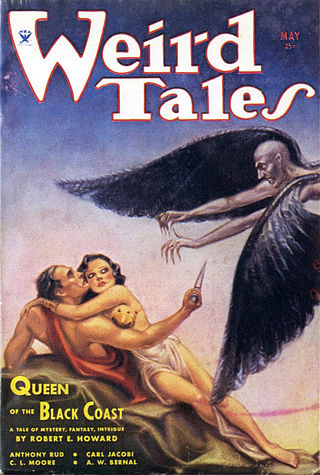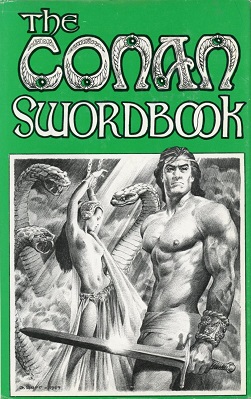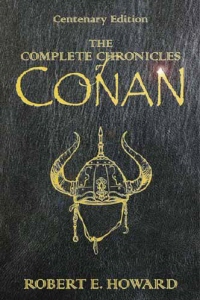
Conan the Barbarian is a fictional sword and sorcery hero who originated in pulp magazines and has since been adapted to books, comics, films, television programs, video games, and role-playing games. Robert E. Howard created the character in 1932 for a series of fantasy stories published in Weird Tales magazine.

The Hyborian Age is a fictional period of Earth's history within the artificial mythology created by Robert E. Howard, serving as the setting for the sword and sorcery tales of Conan the Barbarian.
"The Phoenix on the Sword" is one of the original short stories about Conan the Cimmerian written by American author Robert E. Howard and first published in Weird Tales magazine in December 1932. The tale, in which Howard created the character of Conan, was a rewrite of the unpublished Kull story "By This Axe I Rule!", with long passages being identical. The Conan version of the story was republished in the collections King Conan and Conan the Usurper. It has most recently been republished in the collections The Conan Chronicles Volume 2: The Hour of the Dragon and Conan of Cimmeria: Volume One (1932-1933). It is set in the fictional Hyborian Age and details Conan foiling a plot to unseat him as king of Aquilonia.

"Jewels of Gwahlur" is one of the original short stories starring the fictional sword and sorcery hero Conan the Cimmerian, written by American author Robert E. Howard. Set in the fictional Hyborian Age, it concerns several parties, including Conan, fighting over and treasure hunting for the eponymous treasure in Hyborian Africa. The tale was first published in the March, 1935 issue of Weird Tales. Howard's original title for the story was "The Servants of Bit-Yakin".

"Queen of the Black Coast" is one of the original short stories about Conan the Cimmerian, written by American author Robert E. Howard and first published in Weird Tales magazine c. May 1934. Set during the fictional Hyborian Age, Conan becomes a notorious pirate plundering the coastal villages of Kush alongside Bêlit, a head-strong femme fatale.

"Black Colossus" is one of the original short stories starring the fictional sword and sorcery hero Conan the Cimmerian, written by American author Robert E. Howard and first published in Weird Tales magazine, June 1933. Howard earned $130 for the sale of this story.
"The Slithering Shadow" is one of the original short stories starring the fictional sword and sorcery hero Conan the Cimmerian, written by American author Robert E. Howard and first published in the September 1933 issue of Weird Tales magazine. "The Slithering Shadow" is the original title, but the story is also known as "Xuthal of the Dusk" in further publications. It is set in the fictional Hyborian Age, and concerns Conan discovering a lost city in a remote desert while encountering a Lovecraftian demon known as Thog.

"Shadows in the Moonlight" is one of the original short stories starring the fictional sword and sorcery hero Conan the Cimmerian, written by American author Robert E. Howard and first published in Weird Tales magazine in April 1934. Howard had originally named his story "Iron Shadows in the Moon". It's set in the fictional Hyborian Age and narrates Conan's escape to a remote island in the Vilayet Sea where he encounters the Red Brotherhood, a skulking creature, and mysterious iron statues.

"The Black Stranger" is a fantasy short story by American writer Robert E. Howard, one of his works featuring the sword & sorcery hero Conan the Cimmerian. It was written in the 1930s, but not published in his lifetime. When the original Conan version of his story failed to find a publisher, Howard rewrote "The Black Stranger" into a piratical Terence Vulmea story entitled "Swords of the Red Brotherhood".
"The Hyborian Age" is an essay by Robert E. Howard pertaining to the Hyborian Age, the fictional setting of his stories about Conan the Cimmerian. It was written in the 1930s but not published during Howard's lifetime. Its purpose was to maintain consistency within his fictional setting.
"The Castle of Terror" is a fantasy short story by American writers L. Sprague de Camp and Lin Carter, featuring the fictional sword and sorcery hero Conan the Barbarian created by Robert E. Howard. It was first published by Lancer Books in the paperback collection Conan of Cimmeria (1969), which was reprinted several times, first by Lancer and later by Ace Books through 1993. It has also been published by Sphere Books in the omnibus paperback collection The Conan Chronicles (1989). The story has been translated into German, Japanese, Spanish, Dutch, Italian, French, and Czech.

The Coming of Conan the Cimmerian is the first of a three-volume set collecting the Conan stories by author Robert E. Howard. It was originally published in 2002, first in the United Kingdom by Wandering Star Books under the title Conan of Cimmeria: Volume One (1932–1933) and the following year in the United States by Ballantine/Del Rey under the present title. The Science Fiction Book Club reprinted the complete set in hardcover; the set presents the original, unedited versions of Howard's Conan tales. This volume includes thirteen short stories as well as miscellanea for Howard fans and enthusiasts and is illustrated by comic book artist Mark Schultz.

Conan is a 1967 collection of seven fantasy short stories and associated pieces written by Robert E. Howard, L. Sprague de Camp and Lin Carter featuring Howard's seminal sword and sorcery hero Conan the Barbarian. Most of the stories were originally published in various pulp magazines. The book was first published in paperback by Lancer Books in 1967, and was reprinted in 1968, 1969, 1970, 1971, 1972 (twice) and 1973. After the bankruptcy of Lancer, publication was taken over by Ace Books. Its first edition appeared in May 1977, and was reprinted in 1979, 1982 (twice), 1983, 1984, 1985, 1986, and 1990. The first British edition was issued by Sphere Books in 1974, and was reprinted in 1977. The book has also been translated into German, Japanese, French, Spanish, Italian, Swedish and Dutch. It was gathered together with Conan of Cimmeria and Conan the Freebooter into the omnibus collection The Conan Chronicles.

The Conan Swordbook is a 1969 collection of essays edited by L. Sprague de Camp and George H. Scithers, published in hardcover by Mirage Press. The essays were originally published as articles in Scithers' fanzine Amra. The book is a companion to Mirage's other two volumes of material from Amra, The Conan Reader (1968) and The Conan Grimoire (1972). Most of the material in the three volumes, together with some additional material, was later reprinted in two de Camp-edited paperback anthologies from Ace Books; The Blade of Conan (1979) and The Spell of Conan (1980).

The Blade of Conan is a 1979 collection of essays edited by L. Sprague de Camp, published in paperback by Ace Books. The material was originally published as articles in George H. Scithers' fanzine Amra. The book is a companion to Ace's later volume of material from Amra, The Spell of Conan (1980). Most of the material in the two volumes, together with some additional material, was reprinted from three previous books issued in hardcover by Mirage Press; de Camp's collection The Conan Reader (1968), and the de Camp and Scithers-edited anthologies The Conan Swordbook (1969). and The Conan Grimoire (1972).

The Coming of Conan is a collection of eight fantasy short stories by American writer Robert E. Howard, featuring his sword and sorcery heroes Kull and Conan the Barbarian, together with the first part of his pseudo-history of the "Hyborian Age" in which the Conan tales were set. It was first published in hardcover in the United States by Gnome Press in 1953 and by Boardman Books in the United Kingdom in 1954. The stories originally appeared in the 1930s in the fantasy magazine Weird Tales. The collection never saw publication in paperback; instead, its component stories were split and distributed among other "Kull" and "Conan" collections.
The Blood-Stained God is a 1955 fantasy novella by American writer Robert E. Howard and L. Sprague de Camp, featuring Howard's sword and sorcery hero Conan the Barbarian. It was revised by de Camp from Howard's original story, an unpublished non-fantasy oriental tale that featured Kirby O'Donnell titled "The Curse of the Crimson God". De Camp changed the names of the characters, added the sorcery elements, and recast the setting into Howard's Hyborian Age. The story was first published in the hardbound collection Tales of Conan, and subsequently appeared in the paperback collection Conan of Cimmeria, as part of which it has been translated into German, Japanese, Spanish, Dutch, and Italian. The stories elements were used on the 1976 Peter Pan Records audio drama record: Conan the Barbarian, entitled The Jewel of the Ages.

The Complete Chronicles of Conan: Centenary Edition is a collection of fantasy short stories written by Robert E. Howard featuring his sword and sorcery hero Conan the Barbarian. The book was published in 2006 by Gollancz and is an omnibus of their earlier collections The Conan Chronicles, Volume 1: The People of the Black Circle and The Conan Chronicles, Volume 2: The Hour of the Dragon, though the stories are rearranged. The collection is edited by Stephen Jones and was issued to celebrate the centenary of Howard's birth. Most of the stories originally appeared in the magazines The Phantagraph, Weird Tales, Super-Science Fiction, Magazine of Horror, Fantasy Fiction, Fantasy Magazine and The Howard Collector.

Conan of Venarium is a fantasy novel by American writer Harry Turtledove, edited by Teresa Nielsen Hayden, featuring Robert E. Howard's sword and sorcery hero Conan the Barbarian. It was first published in hardcover by Tor Books in July 2003; a regular paperback edition followed from the same publisher in July 2004.

Conan and the Grim Grey God is a fantasy novel written by American writer Sean A. Moore, featuring Robert E. Howard's sword and sorcery hero Conan the Barbarian. It was first published in trade paperback by Tor Books in November 1996; a regular paperback edition followed from the same publisher in November 1997.















